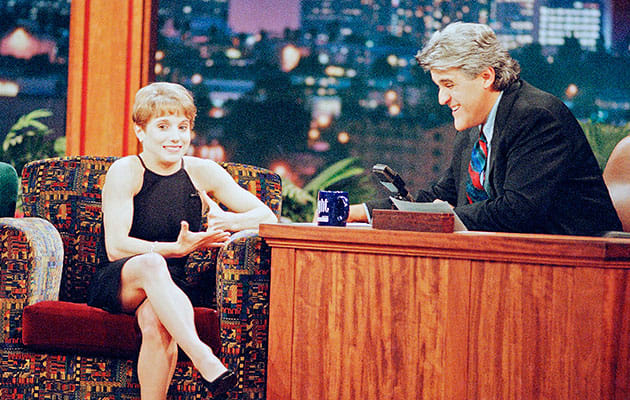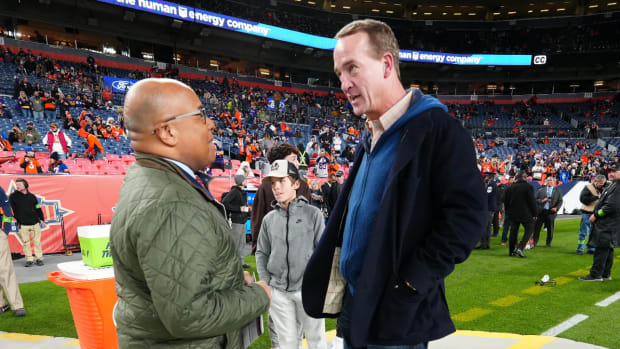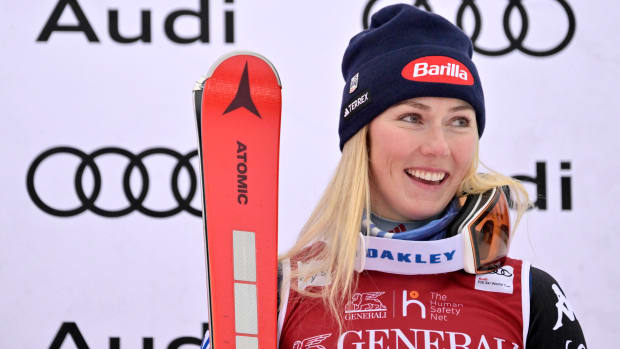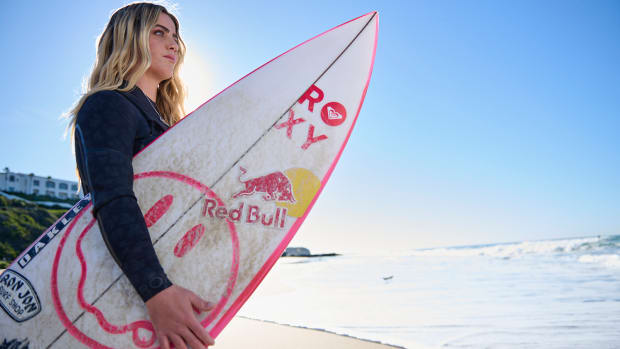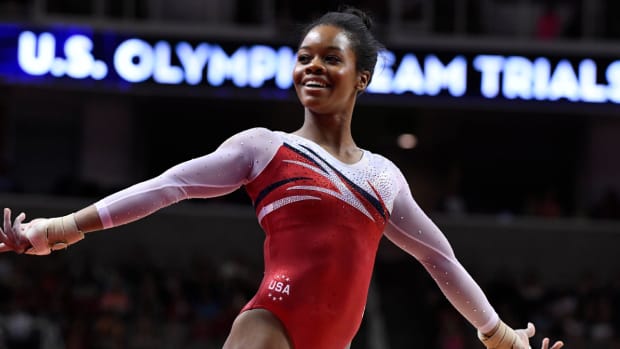The Magnificent Seven: Growing up after their golden 1996 Olympics
From 34 stories above the flat expanse of Oklahoma City, the view spreads endlessly beyond the floor-to-ceiling windows. But the crowd assembled at the International Gymnastics Hall of Fame dinner is looking back instead of down. It’s mid-May inside a ballroom at the Petroleum Club, where waiters clad in tuxedos serve filet mignon in mushroom-Merlot sauce, and highlights of America’s most famous gymnasts unspool across projection screens.
“Good gracious,” whispers Shannon Miller, winner of seven Olympic medals. “We were so young.”
The images depict the gymnasts as time remembers them: a collective of pint-sized teenagers at the 1996 Games in Atlanta, their faces absent makeup, their bodies without an ounce of fat, their bangs arched outward across their foreheads.
Twists. Turns. Contortions. Flips. That’s how they earned their nickname: the Magnificent Seven.
“You should go back to that hairstyle,” Jaycie Phelps jokes to Amanda Borden, who 20 years ago sported a now-regrettable feathery bowl cut.
“Hey,” Borden responds, “it was the ’90s.”
They’re grown up now, these women who submitted themselves to what amounted to a sociological experiment: Take seven Olympians aged 14 to 19, make them celebrities overnight, put them on Wheaties boxes and swell their bank accounts beyond their wildest expectations; then send them out into the world they had ignored while perfecting their craft, and watch their lives fork in every direction. See what happens as they inch or walk or run, not toward fame but away from it, an evolution in reverse. Observe them holding on to stardom for years ... or letting go immediately, traveling at different speeds toward normalcy and middle age as the spotlight dims.
• SI’s Where Are They Now issue: This year’s stories, all in one place
All seven of them married. Six have children. Five—Miller, Borden, Phelps, Dominique Moceanu and Amy Chow—are honored guests at the IGHF banquet. Dominique Dawes and Kerri Strug could not join them. But that’s normal. Eight years have passed since even these five women last gathered in the same room.
On the screens, the video ends as the Americans finish atop the Russians and the Romanians to capture the first team all-around women’s gymnastics gold medal in U.S. history. That’s them, singing the national anthem from atop the medal podium, eyes wet—so young. At Table 26, all these years later, they fight back another round of tears.
“Remember afterward,” Phelps asks, “when we ate gummy bears? We would eat an arm one day, the body the next.”
“Wow,” Miller says. “Twenty years.”
Borden: “I guess we’ve all been busy.”
“Guys, guys. . . . Guys!” Moceanu interrupts as she hoists a glass of Cabernet Sauvignon. The others raise their glasses in unison. “I want to do a cheers. It’s always tough to get us all back together. But I’m so glad, after everything, that we’re here now.”
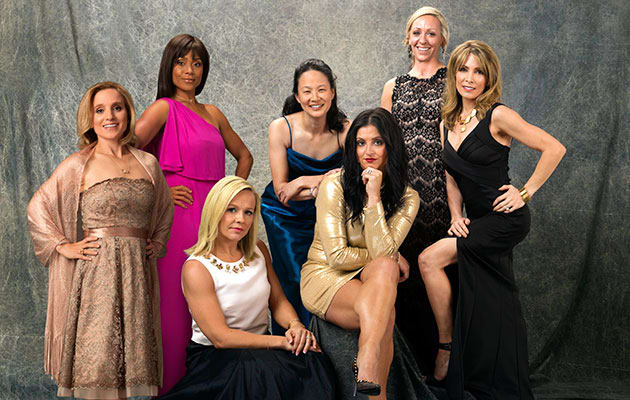
(L-R) Kerri Strug, Dominique Dawes, Amanda Borden, Amy Chow, Dominique Moceanu, Jaycie Phelps, Shannon Miller
Peter Read Miller
The Magnificent Seven arrived in Atlanta roughly a week before the Olympics and moved into a fraternity house at Emory University where they had their own chef and security detail as well as newly installed televisions in each room.
They weren’t a team so much as longtime foes who now happened to be competing together. They had different coaches. The two gymnasts who trained under Béla and Marta Károlyi, Moceanu and Strug, were kept separate from the others, eating and preparing by themselves. “We were competitors first,” says Dawes. Still, seven relative strangers connected at that frat house, like an Olympic version of The Real World.
Dawes, Miller and Strug had competed at the 1992 Games in Barcelona, with Miller winning two silver and three bronze medals; the others each collected a bronze. Chow had fallen at the Olympic trials before Atlanta, her face colliding with a balance beam. Moceanu had not competed at the trials, shelved by a stress fracture in her right tibia that required bone-stimulation treatments. On her first day in Atlanta, Moceanu stopped by an Olympian welcome area. At 14, weighing 75 pounds, she couldn’t find any swag that fit. “I hadn’t even hit puberty yet,” she says.
• Olympic trials preview: Which five gymnastics will be named to 2016 team?
None of them expected to become famous. When reporters asked Chow what she would have done if her trials fall had cost her a roster spot, she shot them a quizzical look. “I’m going to Stanford in the fall,” she said.
Several of the gymnasts watched the opening ceremony together in their Emory living room, placing their hands over their hearts during the national anthem. They didn’t necessarily expect to win, but they knew they were capable.
Later they filed into the Georgia Dome for podium training, where 32,000 admirers screamed throughout their practices. The Russians complained about the noise, but chants of “U.S.A.! U.S.A.!” washed over them.
Looking back, the team events themselves—balance beam, floor exercise, uneven bars and vault—blur together for the gymnasts. Instead they remember random moments: Borden consoling a tearful and nervous Dawes with a sort of prayer before the uneven bars . . . the fly that landed on the balance beam, inches from Miller’s face ... the cries—“Marry me, Amanda!”—from the crowd.
Through three-quarters of the competition the U.S. led second-place Russia by a comfortable margin; only the vault remained, and six of each team’s gymnasts would compete there, with the strongest competitors up last. Moceanu went fifth, after Phelps, Chow, Miller and Dawes. Teammates could not recall Moceanu’s missing a single attempt in training. Then she fell on her first vault . . . and her second, as the crowd let loose a collective gasp. “That’s when I started to get scared,” says Phelps. “You could feel our lead slipping away.”
What happened next turned seven rivals into one magnificent team. Strug went last, and not only did she stumble on her first landing, she also heard her left ankle snap. Her coach, Béla Károlyi, implored her to push on. “You can do it!” he shouted. “You! Can! Do it!”
Strug set up for her second vault, her team’s final chance. She whispered the positive affirmations she’d been taught by a sports psychologist: You will do this. You’re strong. You’re fast. Then she took off as her teammates watched from the end of the runway. No one knew how hurt she really was. Her ankle felt loose, almost unattached. She worried about falling. She told herself, Make it to the springboard. And she did, springing, twisting, turning, falling and ... sticking the landing. As celebration erupted all around, Strug remembers telling doctors not to damage her lucky vaulting shoes. The ankle surged with pain.
• FROM THE VAULT (1996): Strug’s gritty vault leads U.S. women to gold
Later, an international television audience transfixed by seven tiny teenagers watched as they ascended the gold medal platform. Strug was snug in Károlyi’s arms. She had dreamed of that exact moment for 12 years, ever since she had watched Mary Lou Retton accept a gold medal in 1984. She always figured she would look just like Retton, a smile spread wide across her face, and yet one small detail also nagged at her: She wasn’t wearing pants.
The New York Times, meanwhile, placed the Magnificent Seven among America’s elite all-time Olympians, writing that “until now, [the U.S.] has never had a team of women capture so many hearts, imaginations and a gold medal on the world’s biggest sporting stage.”
Strug has never so much as practiced a vault again. Sometimes she can’t believe how she reacted to the win, with a mixture of emotions rather than pure joy, or that she cared even a little about her missing pants. She wanted to celebrate with her teammates and eat a veggie burger. She wanted to rehab in hopes of competing in the individual events. (She didn’t.) At 18, she had no idea she would spend the next 20 years simultaneously reliving that moment and seeking to move away from it.
Strug found her pants and went straight to the hospital, where reporters had camped out in the lobby. While she dealt with two torn ligaments, her teammates sped to Planet Hollywood to attend a party thrown by Bruce Willis and Demi Moore. They later met with the second incarnation of the Dream Team, posing with Shaquille O’Neal and Penny Hardaway. In one snapshot O’Neal lifted Moceanu, lying sideways, above his head, like a standing press. “We were maybe up to their hips,” Phelps says.
The whirlwind continued. Phelps and Borden visited the Olympic Park wearing disguises, baseball hats and sunglasses covering their faces. The gymnasts later lunched with President Bill Clinton and toured the White House. Strug appeared on Beverly Hills 90210 and Saturday Night Live. Someone eventually asked Borden if there was anything left in her life to accomplish. She was 19.
They were children, really, if not in age, then in life experience. They had spent their formative years holed up inside gymnasiums, preparing for the Olympics, but it hit with a force that none of them could have anticipated. Fans sent so many flowers to the frat house that bouquets lined the staircase. Boxes of letters sat unopened on the porch. News outlets across the world wanted interviews. Meanwhile, there was Moceanu in the kitchen, holding brownies in both hands. “Have you tried these?” she asked no one in particular. She had never enjoyed a brownie before.
In the aftermath, while the security detail took the gymnasts to Dairy Queen for Blizzards, commercial interests assumed a primary role. The U.S. coaches met at the house and discussed keeping the seven athletes together post-Olympics in order to maximize their earning potential. The majority of them believed the gymnasts needed to put off college and tour right away. One left the room thinking, “This whole thing was about money.”
The celebrity spin cycle had already started to alter their paths, even as the gymnasts themselves remained relatively unsophisticated. When Miller went on Late Night with Conan O’Brien, she arrived without makeup, wearing jeans, a T-shirt and tennis shoes. “Oh, sweetie,” one NBC employee told her, “you can’t wear that.”
The tour ballooned from 34 cities to more than 90 performances, and the gymnasts traversed the country in their own bus, rock star contortionists performing their Olympic routines to sold-out crowds. Moceanu ate French toast at every opportunity. They went shopping, compared malls. And still they competed—in who could pull off the best pranks, putting milk in someone else’s chalk or hiding each other’s costumes or changing the music for routines. Those wacky little gymnasts!
Six of them, anyway. Strug did a separate tour on weekends, attending UCLA during the week. She eventually joined the others, but a schism had developed. “She had a different opportunity, and that’s fine, but it divided us,” says Moceanu. “Because we were a team, and that’s how we should have stayed. It just didn’t seem right.”
Or . . . “The other girls were jealous,” says Leigh Steinberg, Strug’s agent for about a year following the Atlanta Games. “Kerri was not billed as the star going into those Olympics. But she came into stardom.”
WhenSteinberg first met Strug, after the Olympics, he couldn’t believe “how sheltered and abnormal an adolescence she’d [lived].” No dates. Little junk food. Minimal social interaction outside of gymnastics. “Like the girl in the bubble,” he says. To various extents, they all were.
As the gymnasts shifted in 1997 back into lives that were no longer normal, Strug was the first to try to distance herself from Olympic renown. She had gone on The Tonight Show with Jay Leno, rung the opening bell at the New York Stock Exchange and been carried (again) onto the field during a Monday Night Football game. “It wasn’t one of those things where you’re like, Jeez, I could never run that fast,” Steinberg says. “America could relate to Kerri Strug.”
Strug, meanwhile, wanted to relate to everyday Americans. She had always been shy and sheltered, and she craved a normal college experience after everything settled down. Her parents pushed her to attend UCLA immediately, a decision that she came to agree with only after she lived outside her bubble. “I had to get my life in order,” she says.
On some level, all seven young women identified and wrestled with the same themes, especially right after their tours ended in late 1997. They weighed capitalizing on their newfound fame against moving into the rest of their lives, and they transitioned at different speeds. Some felt more at ease around celebrities than in typical social situations.
• Age isn’t the most important number for 2016 men’s gymnastics team
Before Dawes moved to New York City and appeared on Broadway as the cheerleader Patty Simcox in Grease, she answered the phone in her Orlando hotel room to a caller who identified himself as Prince (or as the Love Symbol, the name by which he was going at that time; she can’t remember which). He wanted Dawes, the first African-American to win Olympic gymnastics gold, to star in his video for the song “Betcha by Golly, Wow!” Reacting as might reasonably be anticipated, Dawes hung up, certain the call was yet another prank. It wasn’t. Prince summoned Dawes to his suburban Minnesota mansion, and when she arrived, in November 1996, he offered her something to drink. She asked for hot chocolate, and Prince made her some Swiss Miss. “My jaw dropped,” she says. In the video she would play a freestyle dancer, but being a gymnast, she struggled to perform anything beyond a planned routine. Prince ended up hiring a choreographer for her.
Moceanu, for her part, carried her vault failure with her for years. She had fallen short of perfection, which meant she had fallen short of her father’s expectations. Dimitry Moceanu had emigrated from Romania to Houston, where he owned a car dealership and dabbled in real estate. He wanted nothing more than for his daughter to become an Olympic champion, but he pushed her with anger and rage and sometimes, she says, with physical abuse.
Dimitry had arranged for his daughter to train with the Károlyis at their ranch outside Houston four years before the Atlanta Games. There she says she saw athletes “pushed through unreasonable workouts into dangerous pain,” as with the shinbone she’d fractured shortly before the 1996 Games. Anyone who complained, she says, “was dismissed as weak or lazy or faking.”
Exercises, she says, lasted for hours and were held outside, in punishing temperatures, with no food or water. After one performance that Károlyi considered especially poor, she says the coach made her stand on a scale in front of other gymnasts. She was not yet 14, and she weighed less than a Doberman. On occasion, she says, Károlyi threatened to call her father following mistakes.
The Károlyis declined interview requests, but to Moceanu’s general recollection Martha Károlyi emailed, “It is too bad she remembers only the hardship and doesn’t remember the good times, the joy of achieving things.” Strug, speaking from her own experiences, also disagrees with Moceanu. “I knew exactly what I was getting into,” she says. “Did I like [the Károlyis] on a daily basis? No. But I chose to stay there. They made me mentally tough.”
Moceanu, meanwhile, accused Dimitry of spending more than $1 million of her earnings. In 1997 her family home near the Károlyi gym flooded, ruining most of her Olympic memorabilia. In ’98 she filed for emancipation from her parents in order to gain control over her finances.
She wondered: Would she ever be happy? Would she ever be normal?
In 2000, Moceanu retired from gymnastics, another medalist in search of a more standard life. Little did she know...
Strug decided to study abroad in 2000, the next Olympic year, electing to enroll in Semester at Sea. Her gymnastics career had taken her everywhere and nowhere—everywhere in that she traveled the world, competing in dozens of countries; nowhere in that wherever she journeyed, she wore a path from the hotel to the gym and back. She never actually saw anything. “I wanted to go to the places I had been and see the culture and immerse myself in it,” she says. “It was liberating and scary, too.”
Her athletic career had been scheduled to the minute. But in Semester at Sea, on a boat that docked at various countries to take in different cultures, Strug could do whatever she wanted. When they docked in India, she had no schedule, and so she wandered the streets as rickshaws whizzed past. In Saigon she played with young children and bought them toys, and visited a pottery village near Hanoi. She fell in love with Cuba, all the houses painted bright blue and orange and yellow, the whole country stuck in time. She even took in a Fidel Castro speech. “It was really interesting to formulate my own thoughts and opinions,” she says. “I wasn’t used to doing that.”
Back at Stanford in the spring of 2001, Strug took the same statistics class as Chow, who was studying to become a pediatrician. Chow had trained for and competed at the ’00 Games in between her studies, at once delaying her transition but also moving forward. She earned her undergraduate degree in ’02 and completed medical school, also at Stanford, in ’07. She took up pole vaulting (career best: 13' 5 1⁄4") and competitive diving, confirming that she loved flying through the air, twisting and turning and flipping, whether she landed on her feet, head or back.
Simone Biles floats to fourth U.S. title; five golds in Rio a possibility
Phelps and Borden became coaches, something neither could have seen coming in Atlanta. Moceanu’s life, meanwhile, carried on like a soap opera. On one rainy night in December 2007, while she was finishing her finals at John Carroll University, nine months pregnant, she opened a package with bubbly handwriting on the front. Inside was a letter from a woman named Jennifer Bricker, who wrote that Moceanu’s parents had given her up for adoption shortly after she was born. Later, as the sisters began corresponding, Bricker dropped another surprise: She had been born without legs. The two remain in regular contact, and Bricker often visits Moceanu at her home outside Cleveland.
Moceanu wrote an autobiography. She lost more of her Olympic keepsakes when a second fire damaged another family home, this one in Spring, Texas, in 2008. Her father died that year from cancer, and Béla Károlyi surfaced at the funeral—the first time Moceanu says she had interacted with him in years. “We don’t have a relationship,” she says. “It’s nonexistent.”
That same year, the Magnificent Seven were inducted into the U.S. Olympic Hall of Fame. All seven made the trip to Chicago, and it marked the last time they were all together. “That’s sad,” Phelps says.
Moceanu graduated from John Carroll in 2009 with a degree in business management. By then most of the gymnasts had transitioned away from celebrity, the occasional appearance or speech notwithstanding. Their moment no longer defined them the way it once did. But it always will, in part. As Moceanu walked across the stage at her graduation, the crowd started to chant, “USA! USA! USA!”
Of all the gymnasts, Dawes and Miller remained in the public eye the longest. Dawes worked first as a gymnastics broadcaster and public speaker, and she was appointed to President Barack Obama’s Council on Fitness, Sports and Nutrition in 2010. That August, she and Chow received retroactive bronze medals from the ’00 Olympics, after the Chinese team that placed ahead of them was disqualified for using an underage competitor.
Miller overcame an early fear of public speaking by giving free talks at Rotary clubs and for nonprofits. At first she mostly detailed her Olympic experience, but the more she spoke, the more her focus evolved. In 2010, three years after graduating from law school at Boston College, she started a company focused on lifestyle, health and fitness for women.
In January 2011, Miller was diagnosed with a rare form of ovarian cancer for which chemotherapy treatments caused her hair loss, pain, fatigue and nausea. Doctors removed a cyst roughly the size of a baseball. Miller attacked cancer the way she approached gymnastics. She was never the fastest competitor or the most graceful; she outworked everyone en route to her place in Olympic lore, as America’s most decorated gymnast.
Strug attended the London Olympics in 2012, and after Team USA wrapped up its first gold medal since the 1996 Games she turned to her husband and gushed, “Their parents must be so proud.” Her perspective had changed that dramatically. “I appreciate when people tell me where they were when I did the vault,” she says. “But in my daily life, I’m just trying to get my kids off to preschool.”
As the 20th anniversary of those 1996 Games approached, Dawes married in 2013 and Phelps followed suit a year later. Dawes became the sixth team member to have children. After years of dating Mr. Right-Nows, she’d found Mr. Right, a teacher named Jeff Thompson. They met online, only to realize that they shared several mutual friends; now they have two young daughters. “I’m totally sleep-deprived,” she says. “I’m forgetful. I wear sweats all day long.”
After Prince and Broadway and Obama, it turns out that Dawes most wanted the same things as her teammates. A husband. Children. Work that doesn’t interfere too often with family. . . . Normalcy, more or less. First, though, she had to learn how to relax. Her life had been so regimented, so focused on achievement. What made Dawes an incredible gymnast sometimes made her an overly critical human being. “You walk around seeing what needs to be corrected without seeing what’s so amazing in life,” Thompson told her.
“That was my life for 18 years,” she says. “I had to rewire my brain. I had to learn how to let go. Look at our team in ’96. You didn’t see us smile; we were pretty intense. That was the culture and the sport back then. That’s why I don’t want my daughters to train for the Olympics.”
Olympians choose the oddest of lives, spending thousands of hours training in and obsessing over worlds that are mostly obscure, putting off college and children and hobbies. They chase a moment and then it’s gone, even for those who find what they wanted—or they find out that what they sought wasn’t actually what they wanted at all.
In the case of seven athletes who lived together in a frat house and sang Warren G’s “Regulate,” 1996 marked an end and a beginning. Everything before led to that moment. Everything after led away.


